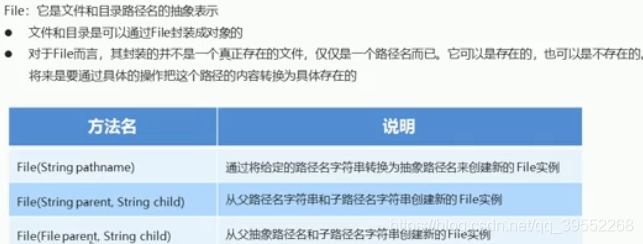java File类的相关操作
本文共 527 字,大约阅读时间需要 1 分钟。
1.File类概述和构造方法
windows系统
- 一个点表示当前目录 直接写文件名字也是如此
- 两个点表示上级目录

注意第三个构造方法 父为对象 子为路径名

直接输出File对象会输出文件的绝对路径因为File类改写了toString()方法,输出时会自动调用
这三个构造方法做了同样的事情
2.File类的创建方法


f4.mkdir()会创建一个名字为javase.txt的文件 如果这时再调用 f4.createNewFile会报false因为已经存在一个名字为javase.txt的目录,在这里目录就是文件的意思 mkdirs只能创建多层目录,如果想创建多层目录+txt文件就用mkdirs+creatNewFile

3.绝对路径和相对路径

4.delete和实例

如果一个文件下有内容,则不能直接删除此文件
5.File常用方法
 、
、

//抽象路径名 绝对路径名和 规范路径名的区别
file.list获取当前文件下的目录或文件的名字
就等于f2.listFiles()方法获取当前目录下所有文件和目录对象后在分别调用他们的getName()方法,但这个方法的好处就是可以通过文件对象来进行各种额外的判断操作如上面展示的
递归遍历一个目录下的所有文件

转载地址:http://ymsi.baihongyu.com/
你可能感兴趣的文章
nginx负载均衡的5种策略(转载)
查看>>
nginx负载均衡的五种算法
查看>>
nginx转发端口时与导致websocket不生效
查看>>
Nginx运维与实战(二)-Https配置
查看>>
Nginx配置Https证书
查看>>
Nginx配置ssl实现https
查看>>
Nginx配置TCP代理指南
查看>>
Nginx配置——不记录指定文件类型日志
查看>>
nginx配置一、二级域名、多域名对应(api接口、前端网站、后台管理网站)
查看>>
Nginx配置代理解决本地html进行ajax请求接口跨域问题
查看>>
nginx配置全解
查看>>
Nginx配置参数中文说明
查看>>
nginx配置域名和ip同时访问、开放多端口
查看>>
Nginx配置好ssl,但$_SERVER[‘HTTPS‘]取不到值
查看>>
Nginx配置如何一键生成
查看>>
Nginx配置实例-负载均衡实例:平均访问多台服务器
查看>>
Nginx配置文件nginx.conf中文详解(总结)
查看>>
Nginx配置负载均衡到后台网关集群
查看>>
ngrok | 内网穿透,支持 HTTPS、国内访问、静态域名
查看>>
NHibernate学习[1]
查看>>